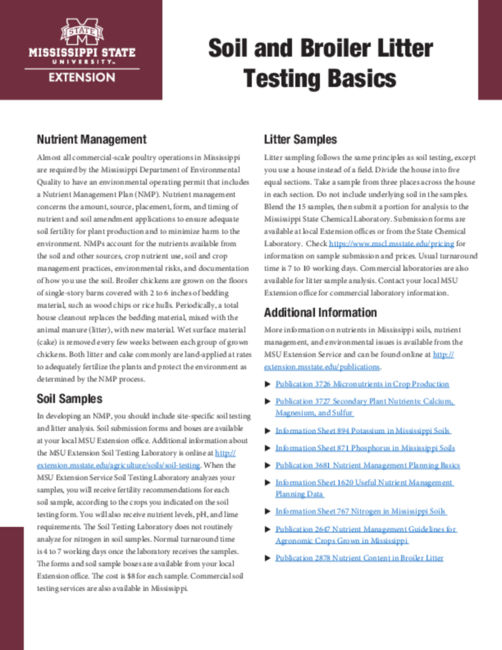P3749
Soil and Broiler Litter Testing Basics
Nutrient Management
Almost all commercial-scale poultry operations in Mississippi are required by the Mississippi Department of Environmental Quality to have an environmental operating permit that includes a Nutrient Management Plan (NMP). Nutrient management concerns the amount, source, placement, form, and timing of nutrient and soil amendment applications to ensure adequate soil fertility for plant production and to minimize harm to the environment. NMPs account for the nutrients available from the soil and other sources, crop nutrient use, soil and crop management practices, environmental risks, and documentation of how you use the soil. Broiler chickens are grown on the floors of single-story barns covered with 2 to 6 inches of bedding material, such as wood chips or rice hulls. Periodically, a total house cleanout replaces the bedding material, mixed with the animal manure (litter), with new material. Wet surface material (cake) is removed every few weeks between each group of grown chickens. Both litter and cake commonly are land-applied at rates to adequately fertilize the plants and protect the environment as determined by the NMP process.
Soil Samples
In developing an NMP, you should include site-specific soil testing and litter analysis. Soil submission forms and boxes are available at your local MSU Extension office. Additional information about the MSU Extension Soil Testing Laboratory is online at http://extension.msstate.edu/agriculture/soils/soil-testing. When the MSU Extension Service Soil Testing Laboratory analyzes your samples, you will receive fertility recommendations for each soil sample, according to the crops you indicated on the soil testing form. You will also receive nutrient levels, pH, and lime requirements. The Soil Testing Laboratory does not routinely analyze for nitrogen in soil samples. Normal turnaround time is 4 to 7 working days once the laboratory receives the samples. The forms and soil sample boxes are available from your local Extension office. The cost is $8 for each sample. Commercial soil testing services are also available in Mississippi.
Litter Samples
Litter sampling follows the same principles as soil testing, except you use a house instead of a field. Divide the house into five equal sections. Take a sample from three places across the house in each section. Do not include underlying soil in the samples. Blend the 15 samples, then submit a portion for analysis to the Mississippi State Chemical Laboratory. Submission forms are available at local Extension offices or from the State Chemical Laboratory. Check https://www.mscl.msstate.edu/pricing for information on sample submission and prices. Usual turnaround time is 7 to 10 working days. Commercial laboratories are also available for litter sample analysis. Contact your local MSU Extension office for commercial laboratory information.
Additional Information
More information on nutrients in Mississippi soils, nutrient management, and environmental issues is available from the MSU Extension Service and can be found online at http://extension.msstate.edu/publications.
- Publication 3726 Micronutrients in Crop Production
- Publication 3727 Secondary Plant Nutrients: Calcium, Magnesium, and Sulfur
- Information Sheet 894 Potassium in Mississippi Soils
- Information Sheet 871 Phosphorus in Mississippi Soils
- Publication 3681 Nutrient Management Planning Basics
- Information Sheet 1620 Useful Nutrient Management Planning Data
- Information Sheet 767 Nitrogen in Mississippi Soils
- Publication 2647 Nutrient Management Guidelines for Agronomic Crops Grown in Mississippi
- Publication 2878 Nutrient Content in Broiler Litter
Publication 3749 (POD-03-22)
Revised by Larry Oldham, PhD, Extension Professor, Plant and Soil Sciences, and Keri Jones, PhD, Extension Associate, Plant and Soil Sciences, from a previous edition co-authored by Craig Coufal, PhD, former Assistant Extension Professor and Poultry Specialist, Poultry Science.
The Mississippi State University Extension Service is working to ensure all web content is accessible to all users. If you need assistance accessing any of our content, please email the webteam or call 662-325-2262.
